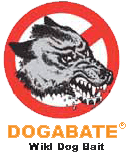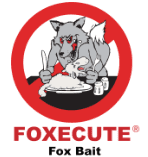 THE time required to get a PAPP-poisoned dog to a veterinarian for life-saving treatment will depend on whether it took a fox or wild dog strength bait, according to the leader of the Blue Healer PAPP antidote project at the Invasive Animals CRC Simon Humphrys.
THE time required to get a PAPP-poisoned dog to a veterinarian for life-saving treatment will depend on whether it took a fox or wild dog strength bait, according to the leader of the Blue Healer PAPP antidote project at the Invasive Animals CRC Simon Humphrys.
“Either way it’s really critical that after noticing the dog has either eaten the bait or the owner is seeing signs of intoxication, the owner gets to a vet as quickly as possible as early intervention will ensure the best recovery.
“It is difficult to put a timeframe to it, as it depends on the size of the dog and how much bait has been ingested, but a dog owner could have anywhere from 45 minutes up to 120 minutes or longer between a dog eating a bait and needing the antidote to be administered,” he said.
Mr Humphrys said it is important for owners to know that the antidote is only one part of the recommended treatment, as the recovery of a poisoned dog will be improved if vets give supportive treatments for both the expulsion of the poison from the digestive tract and the circulation of oxygenated blood.
“For example, one practical thing that dog owners/farmers can do as soon as they see or suspect a dog has eaten a bait is administer 2-3 washing soda (sodium carbonate) chunks to dogs just like they would a tablet.
“Washing soda is available in most supermarkets in the cleaning section and this treatment is quite safe and effective at making dogs vomit so a pack of washing soda crystals in the glove box of the ute might save the day or at the very least buy you time to get to a vet.”
Bait manufacturer Animal Control Technologies Australia has said the 1080 and PAPP baits have been upgraded with scat marker beads incorporated to enable fast diagnosis of the type of bait that has been eaten. This provides vets with an additional diagnostic aid to confirm lack of bait uptake in some unexplained dog deaths. Use of different colour marker beads will indicate the best treatment to a working dog that has taken either type of bait. Scat beads can also be found in fox and wild dog carcasses as confirmation of bait effectiveness.
The Australian Veterinary Association said once ingested, PAPP works by converting normal haemoglobin to methaemoglobin. Clinical signs include lethargy, ataxia, unresponsiveness, unconsciousness and death. Animals with PAPP poisoning also display grey-blue gums and tongue, caused by the change in blood colour from red to brown.
Domestic dogs less affected by PAPP fox baits
 ACTA has previously said that a domestic dog could die within half an hour of ingesting a PAPP bait. However, the AVA said the carefully-considered PAPP dose in fox baits means an average-sized working dog will be less affected after eating one fox bait, but treatment should be sought immediately. Due to the higher dose in wild dog baits, if a domestic or working dog eats just one dog bait, it will die within 1-2 hours if there is no treatment with antidote, the AVA said.
ACTA has previously said that a domestic dog could die within half an hour of ingesting a PAPP bait. However, the AVA said the carefully-considered PAPP dose in fox baits means an average-sized working dog will be less affected after eating one fox bait, but treatment should be sought immediately. Due to the higher dose in wild dog baits, if a domestic or working dog eats just one dog bait, it will die within 1-2 hours if there is no treatment with antidote, the AVA said.
Mr Humphrys said the choice by a land manager to use PAPP or any other control tool will always depend on many factors and the industry was lucky to have a new tool that provided more choice for an increasing number of land managers in new locations. Each control method has its advantages and disadvantages in different circumstances of geographical location, time of year, weather, labour availability, cost, mode of delivery and non-target impact.
“The choice by a land manager to use PAPP or any other control tool will always depend on many factors and we are lucky to have a new that provides more choice for an increasing number of land managers in new locations.”
To inform land managers, the CRC is rolling out a number of events at field days in collaboration with ACTA, AWI and the National Wild Dog Action Plan to provide advice on PAPP use and integration with other tools. There is also the PestSmart fact sheets available at www.pestsmart.org.au/PAPP
FOXECUTE® PAPP baits for foxes and DOGABAIT® PAPP baits for wild dogs have been approved by the APVMA, but legal instructions and restrictions for use are found on the approved product labels and must be followed. In addition, some constraints differ between states, so local instructions must also be followed. Approved labels and MSDS sheets are available on the ACTA web site: (http://www.animalcontrol.com.au/MSDS.htm).
Due the imposition of Restricted S7 scheduling on PAPP baits by the National Drugs & Poisons Scheduling Committee, only approved users can access PAPP bait products. Approvals and some constraints may differ between States, so local instructions must also be followed.

Could sodium bicarbonate be used instead as it is more likely to be found in homes than washing soda? Editor’s note: Sandra, I am advised by a veterinarian that sodium bicarbonate is unlikely to cause a dog to vomit, it is just alkaline and not an irritant, unlike washing soda. There is also a risk with washing soda; giving too much can lead to gastric ulcers. The washing soda also has to be fresh and not spoiled by water — ideally from an unopened bag — to have the best effect. Salty water can also be used to as an emetic, but no more than half a cup as a drench, and care must be taken to ensure it doesn’t get on the lungs. The best course of action is to get any potentially poisoned dog to a vet as soon as possible.